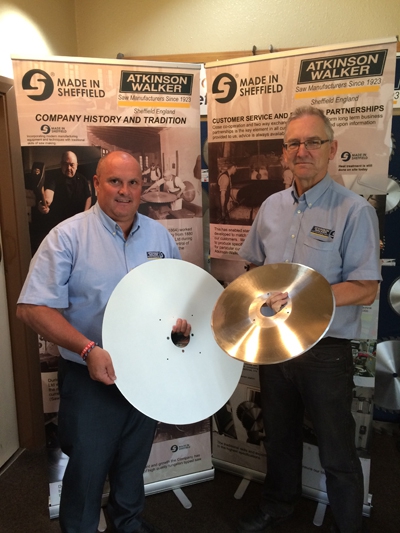
Atkinson Walker Saws has expanded its product range to include log saw blades, which are used in paper goods, wet wipe and disposable nappy industries across the globe.
The company, which recently celebrated its first anniversary under new ownership with a visit from the Master Cutler, has set up a new manufacturing facility at the historic building on Cotton Mill Row to meet expected demand for the blades.
Chairman Nick Alexander quality products for generations and we are delighted to expand our range. There was a gap in the market for a reputable supplier of log saw blades and because of our commitment to growing the business, we chose to invest in machinery to produce these."
The company aims to eventually manufacture the full range of log saw blades and supply the consumable products which complement the blades in production.
General Manager Mark Rowley plans to grow the workforce to ensure the company are truly competitive in the marketplace. Rowley said: "The production of log saw blades not only secures the jobs of our existing workforce, it also means we can look to bring in apprentices who we can teach the art and tradition of manufacturing to, ensuring the future of the company. Blending technology together with these traditional skills is the way forward."
Currently, there are no apprenticeship schemes available within this industry but this hasn't deterred Rowley, who plans to create his own training facility within Atkinson Walker Saws, with the full backing of local entrepreneurs Nick Alexander, Terry Lee, Mark Stanley and Chris Sellars, who acquired the business 12 months ago.
Contact Details
Related Glossary Terms
- backing
backing
1. Flexible portion of a bandsaw blade. 2. Support material behind the cutting edge of a tool. 3. Base material for coated abrasives.
- milling machine ( mill)
milling machine ( mill)
Runs endmills and arbor-mounted milling cutters. Features include a head with a spindle that drives the cutters; a column, knee and table that provide motion in the three Cartesian axes; and a base that supports the components and houses the cutting-fluid pump and reservoir. The work is mounted on the table and fed into the rotating cutter or endmill to accomplish the milling steps; vertical milling machines also feed endmills into the work by means of a spindle-mounted quill. Models range from small manual machines to big bed-type and duplex mills. All take one of three basic forms: vertical, horizontal or convertible horizontal/vertical. Vertical machines may be knee-type (the table is mounted on a knee that can be elevated) or bed-type (the table is securely supported and only moves horizontally). In general, horizontal machines are bigger and more powerful, while vertical machines are lighter but more versatile and easier to set up and operate.
- sawing machine ( saw)
sawing machine ( saw)
Machine designed to use a serrated-tooth blade to cut metal or other material. Comes in a wide variety of styles but takes one of four basic forms: hacksaw (a simple, rugged machine that uses a reciprocating motion to part metal or other material); cold or circular saw (powers a circular blade that cuts structural materials); bandsaw (runs an endless band; the two basic types are cutoff and contour band machines, which cut intricate contours and shapes); and abrasive cutoff saw (similar in appearance to the cold saw, but uses an abrasive disc that rotates at high speeds rather than a blade with serrated teeth).






